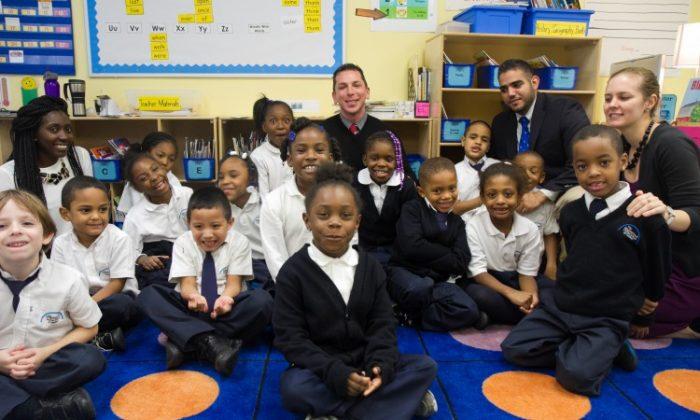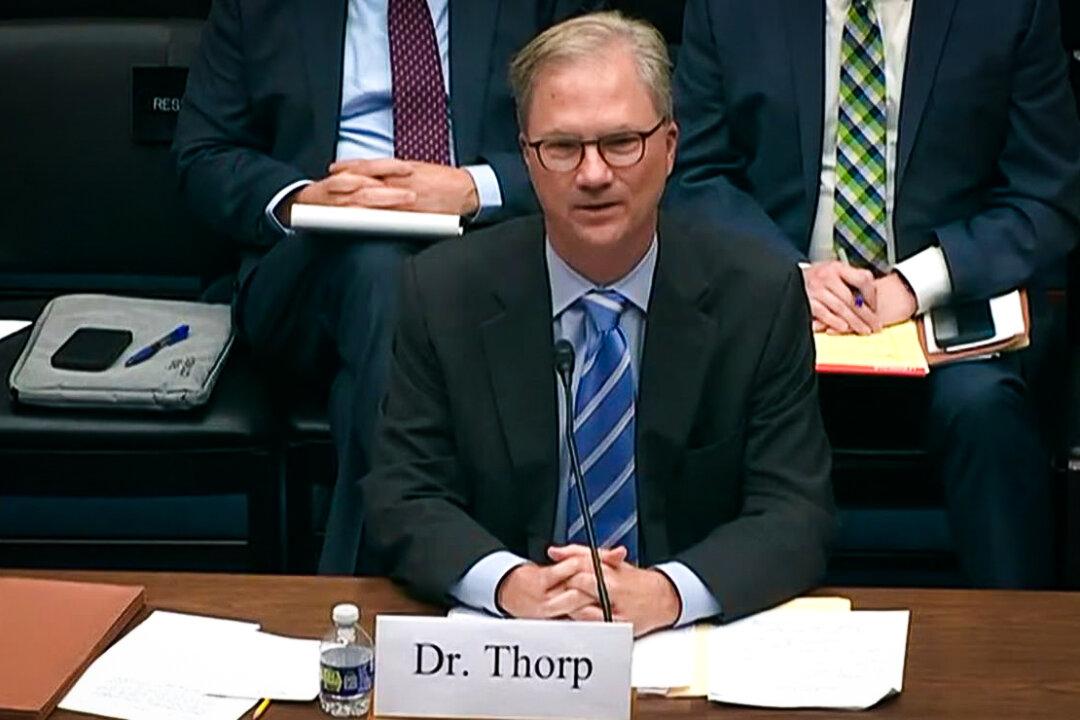NEW YORK—Hands-on learning, a structured environment with daily yoga, and an emphasis on producing good human beings. Welcome to the Neighborhood Charter School of Harlem.
On a recent weekday, a group of first-graders were almost silent while having their post-yoga snack, in a softly lit room, with gentle music flowing.
“This is what calms them, when they take their break with snack and yoga,” said principal Brett Gallini. “So now they’re just relaxing for a few minutes.”
Emphasis on Early and Progressive Learning
The number one goal of Gallini and the staff is to get the young students reading.
Students read 10 books a day, twice a day.
“We want them to practice reading over and over and over—for confidence, for comprehension—because in the early grades, when kids are reading, a lot of it is just decoding, and they’re not getting the comprehension piece,” said Gallini.
Teachers help students learn how to love reading and writing through different strategies, such as choosing books carefully, asking questions about what they are reading, and planning what they will write before they write it.
The overall instruction stems from the workshop model. Students gather on a large carpet for direct instruction from a teacher. Then they sit at desks and practice what was instructed.
Gallini, a former elementary school teacher and district school principal, has been in the education sector for 16 years.
After joining the founding team in January, Gallini and the rest of the School Leadership Team, Deyvis Salazar, director of special education, and Shereta Smith, director of operations, studied high-achieving schools to help them develop the best curriculum. The school opened in August.
Science is another subject emphasized by Gallini and the leadership team.
The old “meaningless” ways of science—“read pages one through six, and answer six questions”—are replaced by hundreds of experiments each year, and a separate science class, Gallini said. “Science can just be so awesome if it’s done correctly, and if it’s not done correctly, it can look like readings, and we really wanted it to look and feel different.”
Math also has a different feel. Students are encouraged to think creatively about solutions.
One of the latest problems students solved included a nature walk where students were instructed to collect 25 acorns. Upon their return, they gave seven acorns to their teacher. How many are left?
“Some kids figure it out, they just know it,” said Gallini, snapping his fingers, “some kids will use the number line (on top of the wall), and some kids will get unifix cubes from the math area and count out and subtract.”
Then they share their different approaches with the rest of the class.
“They learn that you can approach and solve problems with very different strategies,” said Gallini. “This type of math wasn’t taught, at least when I was a kid, and I think that’s why my generation, we’re all so terrified of math.”
Field trips to nearby places—Barnes & Noble, Riverside Park, and the sidewalk just outside the school—are highly encouraged.
“We could sit there and just spew information all day long,” and the teaching would be in one ear and out the other, said Gallini, “but when they’re really rolling up their sleeves and getting involved … it’s so much more meaningful for the kids.”
Teachers Who Perform
The leadership team chose their teachers carefully, selecting 13 from more than 400 applicants.
“I have a very specific recipe for what I think makes a phenomenal teacher,” says Gallini. “You’ve got to obviously have your pedagogy down and have your content, but you’ve got to be a performer.”
Teachers, particularly with younger students, need to become an actor or actress, says Gallini.
“Let’s face it—if you can’t captivate an audience of 20 kids, you’re wasting everybody’s time,” he said. “You’ve got to get these kids engaged and captivate them, and get them excited about things which aren’t necessarily so exciting to a 4-year-old, like learning math facts.”
Connection to prior learning for younger kids is tough, so new concepts are presented visually and physically. During a tour of the school, teachers engaged students using different techniques.
In one class, the teacher sang an introductory song before telling a story about her and her friends carving a pumpkin, using a book to teach new vocabulary.
While learning about Egypt, a smartboard (a digital interactive screen) was used to zoom in on the Nile River on Google Earth.
In another class, a teacher led guided reading of a book about hats, while showing different hats on an iPad and explaining why people wear hats.
A teacher in a different class brought hats in for students to wear while reading the book.
Optimizing Teacher Time
The school designates two teachers to each class, one general education and the other special education. Almost 30 percent of the 118 enrolled students (475 applied) are special education students.
These students, many with autism, are treated the same as others. Those experiencing behavioral problems—such as difficulty making eye contact—stop in at a special class with a speech pathologist, where they subtly work on improving social and learning skills through playing games, such as Jenga.
“I'll argue that aside from being a doctor or something like that, I think it’s the hardest job in the world,” says Gallini. “It just takes a tremendous amount of patience and hard work.”
Gallini himself is often in classrooms and subs for teachers who are sick.
But while the teaching is tough, the bar has been set very high.
“We need our kids to be several years above grade level, and we’re working to close that achievement gap that exists in the city,” said Gallini.
Gallini plans the curriculum framework. Then, during a weekly meeting—while students are learning about being good people from the two full-time culture associates (who work on making the school an enjoyable place)—teachers present next week’s lesson plans for feedback. Each of the six teachers in each grade is in charge of designing a week of lessons for one subject.
“It’s really important to do whatever it is that we can do to make sure the lessons are fun and engaging for kids,” Gallini said.
The Epoch Times publishes in 35 countries and in 19 languages. Subscribe to our e-newsletter.
Please send news tips to [email protected]
















Friends Read Free